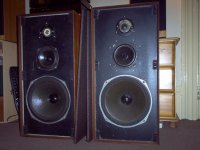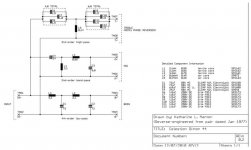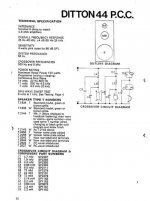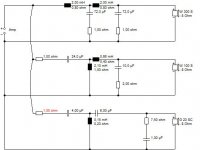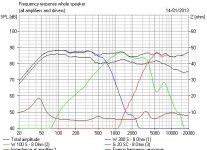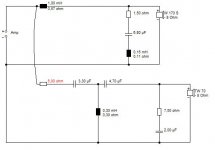Coils are fine. Don't touch. See how you like it when repaired.
I did a totally different grill cloth by framing a sheet of 1/2 inch thick felt. This did wonders for the imaging and diffraction. I never loved the tweeters. Much better ones are out there not, but the mid and woofer were great drivers. Some internal cabinet work could help with resonances. The front and rear are coupled by the mid chamber. Clever. If I remember, foam stuffing. It has been a long time. Mine were teak and had about 50 coats of oil on them. Very nice.
Hmm interesting! This would be a speaker I wouldn't mind doing some mods to.
I can get you some better pictures if you wouldn't mind providing some pointers?
Hmm is replacing the coils necessary? They should be OK, shouldn't they?
of course they should be fine; again earlier you spoke of replacing them.....
have fun.
of course they should be fine; again earlier you spoke of replacing them.....
have fun.
I did? I certainly don't recall that.. well, regardless, I only meant to replace the capacitors.
oh. My apologies. It was another poster.
All good!
I'm looking to be ordering the replacements beginning of August, and when they come in the work will be done right away. So I'd say about a week into August these puppies will be restored.
Once that is done I shall report back.
Thanks again for all of your help guys.
So in the process of restoring these classic speakers, I decided to restore the finish to the wood. Also, the capacitors have been ordered (wife agreed to let me get 'em early!) and so I will be fixing them up next week. 
Here are some pictures of the before and after:
I think they turned out great.
And then the two of them, with my IMF's:
Here are some pictures of the before and after:
An externally hosted image should be here but it was not working when we last tested it.
An externally hosted image should be here but it was not working when we last tested it.
I think they turned out great.
And then the two of them, with my IMF's:
An externally hosted image should be here but it was not working when we last tested it.
Hey guys, thought I'd post back now that the crossover caps have been changed.
Well, they sound a million times better. I'm very impressed with these speakers.
Thank goodness nothing was busted driver wise.. all tested out fine, and it was definitely those capacitors. Gotta love it when it works out like that!
Thank you all for your help.. it was much appreciated.
Well, they sound a million times better. I'm very impressed with these speakers.
Thank goodness nothing was busted driver wise.. all tested out fine, and it was definitely those capacitors. Gotta love it when it works out like that!
Thank you all for your help.. it was much appreciated.
So in the process of restoring these classic speakers, I decided to restore the finish to the wood. Also, the capacitors have been ordered (wife agreed to let me get 'em early!) and so I will be fixing them up next week.
Here are some pictures of the before and after:
An externally hosted image should be here but it was not working when we last tested it.
An externally hosted image should be here but it was not working when we last tested it.
I think they turned out great.
And then the two of them, with my IMF's:
An externally hosted image should be here but it was not working when we last tested it.
What did you use to clean up your 44's??
No problem. 
I use Howard's for just about all of my speakers. Vintage speakers tend to have tired looking wood, and this stuff rejuvenates it and makes it look like new!
Another example, did this on a pair of IMF's I have:
Before:
After:
Quite a difference
I use Howard's for just about all of my speakers. Vintage speakers tend to have tired looking wood, and this stuff rejuvenates it and makes it look like new!
Another example, did this on a pair of IMF's I have:
Before:
An externally hosted image should be here but it was not working when we last tested it.
After:
An externally hosted image should be here but it was not working when we last tested it.
Quite a difference
Hey guys, thought I'd post back now that the crossover caps have been changed.
Well, they sound a million times better. I'm very impressed with these speakers.
Thank goodness nothing was busted driver wise.. all tested out fine, and it was definitely those capacitors. Gotta love it when it works out like that!
Thank you all for your help.. it was much appreciated.
Ciao Jeffrey88
nice 3d- I'm also the owner of ditton 44
About the 4 black elcap caps, I don't know if I need to maintain identical values (at least for capacity) or if is possible a certain tolerance (+- 10% ) without distorting the original sound. What do you think about it?
Yours new caps are polyprop. or other type? Is hard to find perfectly identical values...
Many Thanks for your help
.........................Marco
capacitors for Celestion 44 crossover restoration
I have posted a lot about restoring the crossover in the Celestion 44 in the thread titled:
Crossover nightmare!!!!!!!
started by:
lorienblack
including how to keep the basic audio character of the 44 whilst getting a greater degree of clarity.
There are some other tips there also by 44 owners ,
including one about a fault that develops in the board the lead connection terminals are mounted on , and that should be checked !
There is no Flag beside your name mogwai60/Marco ,
thus I do not know what Nation you are in to advise where you can buy capacitors from.
In the Crossover nightmare!!!!!!! thread I posted some Mail-order sellers ,
and why to use only particular combinations of capacitors to sum to get the unusual cap values of the originals.
I have posted a lot about restoring the crossover in the Celestion 44 in the thread titled:
Crossover nightmare!!!!!!!
started by:
lorienblack
including how to keep the basic audio character of the 44 whilst getting a greater degree of clarity.
There are some other tips there also by 44 owners ,
including one about a fault that develops in the board the lead connection terminals are mounted on , and that should be checked !
There is no Flag beside your name mogwai60/Marco ,
thus I do not know what Nation you are in to advise where you can buy capacitors from.
In the Crossover nightmare!!!!!!! thread I posted some Mail-order sellers ,
and why to use only particular combinations of capacitors to sum to get the unusual cap values of the originals.
Last edited:
Looks like I've just joined the Celestion Ditton 44 club. £60 at my local charity shop. The guys there told me I just missed some Tannoy Berkeley speakers that needed a bass refoam @£150. 
Uploaded with ImageShack.us
Haven't even fired them up yet, but the standard 104mm tweeter rebate should get me out of jail if the mylar tweets are fried, which they might not be since the guys in the shop said they sounded good. Missing a tweeter mesh on one, but hey!
An externally hosted image should be here but it was not working when we last tested it.
Uploaded with ImageShack.us
Haven't even fired them up yet, but the standard 104mm tweeter rebate should get me out of jail if the mylar tweets are fried, which they might not be since the guys in the shop said they sounded good. Missing a tweeter mesh on one, but hey!
Attachments
'ullo system7 ,
you got the 44s or a good price ...
... assuming sufficient of the drivers still work well in them , and if not the tweeters ,
then if I am remembering correctly from what I read in another of your posts
you know about the SEAS 19TFF_1/H0737 which can be got to work well in the Celestion Ditton 44 , and 66 , models.
Don't worry about the Flange size - the SEAS tweeter sits there well enough.
I see you have Katharine Manton's schematic ,
thus you will already know some of what has been posted in the Crossover nightmare!!!!!!! thread ,
and we have discussed adapting the SEAS tweeter there ,
as well as upgrading the capacitors in the old crossover.
If you would like to join us there and report on your progress with your 44s ,
then please do , as the more user reports the better it can be for all owners !
you got the 44s or a good price ...
... assuming sufficient of the drivers still work well in them , and if not the tweeters ,
then if I am remembering correctly from what I read in another of your posts
you know about the SEAS 19TFF_1/H0737 which can be got to work well in the Celestion Ditton 44 , and 66 , models.
Don't worry about the Flange size - the SEAS tweeter sits there well enough.
I see you have Katharine Manton's schematic ,
thus you will already know some of what has been posted in the Crossover nightmare!!!!!!! thread ,
and we have discussed adapting the SEAS tweeter there ,
as well as upgrading the capacitors in the old crossover.
If you would like to join us there and report on your progress with your 44s ,
then please do , as the more user reports the better it can be for all owners !
Last edited:
I've got a few problems with these babies as it goes...
1) One of the woofers has a badly frayed wire connecting the chassis to the cone, which will break at any moment. I may simply replace them with something similar in the 12" line in the long run.
2) One of the mylar HF2000 tweeters is a clumsy repair with a badly beat up dome, and a mesh I've had to remove since it was glued on wrong.
3) The cabinets aren't a match. One has a cardboard tube on the mid, one has a 3L chipboard box, both heavily stuffed. This should be an easy fix, but getting the bolts and tee nuts off the midrange with the cardboard tube was destructive due to glue everywhere. I had to cut them off in the end.
For all that, they sound nice, albeit with a bit of cone breakup from the largish 6" mid. My sim (below) surprisingly suggests that all drivers should be wired in phase. This makes sense actually. The Visaton G20SC tweeter looks an OK replacement near 86dB efficiency similar to the SEAS 19TFF, but I've no problem with attenuating something different.
Will post some pictures as it progresses. I think this will be a nice speaker when updated, but I can't see any suitable midrange replacement on a 137mm cutout yet. Awkward size by modern standards.
I did find that replacing electrolytics with film types might be tricky except in the high pass. The filter relies on electrolytic ESR for damping.
An externally hosted image should be here but it was not working when we last tested it.
1) One of the woofers has a badly frayed wire connecting the chassis to the cone, which will break at any moment. I may simply replace them with something similar in the 12" line in the long run.
2) One of the mylar HF2000 tweeters is a clumsy repair with a badly beat up dome, and a mesh I've had to remove since it was glued on wrong.
3) The cabinets aren't a match. One has a cardboard tube on the mid, one has a 3L chipboard box, both heavily stuffed. This should be an easy fix, but getting the bolts and tee nuts off the midrange with the cardboard tube was destructive due to glue everywhere. I had to cut them off in the end.
For all that, they sound nice, albeit with a bit of cone breakup from the largish 6" mid. My sim (below) surprisingly suggests that all drivers should be wired in phase. This makes sense actually. The Visaton G20SC tweeter looks an OK replacement near 86dB efficiency similar to the SEAS 19TFF, but I've no problem with attenuating something different.
Will post some pictures as it progresses. I think this will be a nice speaker when updated, but I can't see any suitable midrange replacement on a 137mm cutout yet. Awkward size by modern standards.
I did find that replacing electrolytics with film types might be tricky except in the high pass. The filter relies on electrolytic ESR for damping.
Attachments
a reply to #56 above
'ullo system7 ,
I will reply in the Quote Box below after my inserted ---> following each of your points
Additional:
In this thread on Page 1 , Post #6 is one variation of an original 44 crossover -{ = MkI } , and #8 is a MkII crossover.
The crossover in your Post #2 looks like a Celestion crossover board from another model of their l'speakers from about the MkII Ditton era ,
albeit with later manufactured non-polar electros substituted by a restorer.
'ullo system7 ,
I will reply in the Quote Box below after my inserted ---> following each of your points
1) One of the woofers has a badly frayed wire connecting the chassis to the cone, which will break at any moment. I may simply replace them with something similar in the 12" line in the long run.
---> Inspect where the wire is frayed. If it is strong enough at the termination point at each end , then solder a flexible copper wire to each of those points , and in Parallel with the existing wire.
There is no need to remove the old wire for a woofer unless it breaks.
Use a thin tinned braid that can be bought from electronics parts suppliers ,
or , strip an old Interconnect Cable and use either its braid shield or its centre core.
Scrape clean the surface of the wire you decide to use so as no surface oxide.
It will be difficult to thoroughly clean the end points of the wire attached to the woofer ,
but try scraping gently with a very sharp razor blade , or apply a small amount of an oxide disolving compound - small enough to not detrimentally affect the cone at that termination point.
As I think you will realize , you will have to be fast when soldering to the on-cone end - try with a pre-heated very hot iron , and touch to a piece of resin-core solder that is held over the the junction of old and new wires ...
... yes , easy for one to say , but harder to do , especially with only 2 hands to use !
Do you have some-one with a stready hand who can assist , and who will understand what you are trying to do and not move till the solder sets.
I blow on solder joint as soon as I remove iron when doing these heat sensitive jobs.
The woofer is 4 ohms nominal.
Sometimes old Celestion woofers are posted on ebay.
I don't know of any modern woofers that will easily substitute , thus you would have to substantially change the woofer filter section with modern 12" woofers.
Its Sensitivity is about 90dB at 1 metre or possibly 91dB.
*
2) One of the mylar HF2000 tweeters is a clumsy repair with a badly beat up dome, and a mesh I've had to remove since it was glued on wrong.
---> If the dome is dented then may as well replace both , or try to buy an old one via ebay ,
though I would sell the working one on ebay unless you intend to later sell the restored 44 to a collector.
*
3) The cabinets aren't a match. One has a cardboard tube on the mid, one has a 3L chipboard box, both heavily stuffed. This should be an easy fix, but getting the bolts and tee nuts off the midrange with the cardboard tube was destructive due to glue everywhere. I had to cut them off in the end.
---> read through the Crossover nightmare!!!!!!! thread , as LucasAdamson there mentioned the existence of two different midrange drivers ,
but if both your drivers have same size magnet , and are otherwise visually identical , then simply make a new mid encolsure of same volume as the one you are keeping , and stuff it exactly the same ... and hopefully the existing stuffing from the other enclusure is OK and sufficient quantity.
*
For all that, they sound nice, albeit with a bit of cone breakup from the largish 6" mid. My sim (below) surprisingly suggests that all drivers should be wired in phase.
---> you can listen with all the drivers connected in same Polarity ,
but remember that with tweeter polarity flipped over will cause the Vertical Off-Axis peak and dip lobes to flip also , that is: the above one to below axis and the below one to above axis.
This will cause a different frequency spectrum in the reflection from the top of cabinet lip overhanging the baffle.
I advise that the entirety of the underside of this lip be covered in wool or very soft wool felt , or similar ,
and with an open-cut edge facing down at the tweeter.
---> what brand/model mid-driver did you use for your Simulation ?
*
The Visaton G20SC tweeter looks an OK replacement near 86dB efficiency similar to the SEAS 19TFF, but I've no problem with attenuating something different.
---> If I have read the Visaton data correctly , that tweeter is 89dB ...
and that would cause a flat frequency response across mids and treble , because the old Celestion HF2000 was 87dB or less.
{ Actually it had a downwards sloping frequency response from about 89dB at low end to about 85dB from about 16kHz to almost 20kHz.}
If you want a modern sound then stay at 89dB , but restorers of both 44 and 66 model Celestions in this Forum have posted prefering the SEAS 87dB tweeter.
The Visaton plot shows slightly less than 6 ohms almost flat Impedance ...
which is good , as you can connect 100 ohm or slightly higher resistance in Parallel with that tweeter to reduce its middle area impedance to the amount suitable to cross at 5kHz with the existing 0.14mH inductor ,
though you will need to use 3.6uF and 11uF for the capacitors ,
because the old HF2000 did not have a flat frequency response.
{ You can use 3.9uF and 10uF with the .14mH inductor , however there will then be a slight emphasis hump in the frequency response at a frequency a little higher than 5kHz , and of less than half an octave bandwidth.}
Celestion used the 4uF and 6uF , along with .14mH , to reduce the HF2000's excess at the low end of its bandwidth.
The SEAS 19TFF_1 and that Visaton tweeter do not need the extra filtering at their low end.
I have posted more about this in the Crossover nightmare!!!!!!! thread ,
and also in the:
celestion 66 needs Mid-range
thread , started by:
Mr_White
The Visaton G_20_SC has more Ferro Fluid damping than the SEAS 19TFF_1 , thus another at least slightly audible difference in their sounds.
*
Will post some pictures as it progresses. I think this will be a nice speaker when updated, but I can't see any suitable midrange replacement on a 137mm cutout yet. Awkward size by modern standards.
---> if the old mid-drivers are working , and have no audible buzzing , and minimal cone-scrape noise , then use them.
Their sound is OK , and to get better you will have to design a new crossover for whatever new model cone-driver you replace them with.
*
I did find that replacing electrolytics with film types might be tricky except in the high pass. The filter relies on electrolytic ESR for damping.
---> I have posted extensively about compensating for the ESR by connecting resistors in Series with polypropylene caps ,
in both the Threads I listed above.
The 66 thread is very long , and we discuss many topics in it , some concurrently ,
but go to Page 21 there to my #206 for more about the ESR subject , and then after Page 30 for examples.
Similar in the Crossover nightmare thread is easier to find as that is shorter.
Both threads include listener reports about after the resistors' installation.
*
I am puzzled that you used 8 ohm for the drivers in your simulation ... ?
and that you changed the input Inductor of the woofer filter to 2mH ... ?
The values Katharine Manton stated on her schematic are correct , or very close to , for all mH.
Where you have drawn resistors connected to the 72uF caps is correct for ESR compensation ,
though I recommend increasing the resistance to 1.5 ohm for the output 72uF cap.
For the mid-driver's filter , there has been at least two , and perhaps three variations by Celestion during the life of the original 44 , and another variation in the MkII. ,
all sucessively reducing the capacitance for the input cap of that filter.
I recommend you use no larger than 30uF for the input cap , and start with about 1.8 ohms series connected to it.
You can use less , eg: 27uF , 25uF , 24uF ... I would choose whichever is simplest to buy as a single capacitor.
{ I have posted about Single capacitor advantage over Parallel pairs of not-equal capacitances in both the above listed threads.}
The output cap you have marked as 10uF ... ?
It is 6uF for the Celestion drivers , and I recommend you start with about 2.7 ohms in Series with it.
Additional:
In this thread on Page 1 , Post #6 is one variation of an original 44 crossover -{ = MkI } , and #8 is a MkII crossover.
The crossover in your Post #2 looks like a Celestion crossover board from another model of their l'speakers from about the MkII Ditton era ,
albeit with later manufactured non-polar electros substituted by a restorer.
Thanks for your detailed reply, Alan. The Dittons are #4 on my list of outstanding projects, but I think they will be the best. It's an early Mark 1 as it goes. 
You are right, that bass cone loose wire shouldn't be too hard to fix. I have seen a professional speaker repairer do this sort of stuff in 10 minutes.
My Visaton sim was really an attempt to understand the speaker with modern equivalents. The tweeter is an easy replacement with the 91dB Mylar Monacor DT-19SU: MONACOR INTERNATIONAL : Product Detail Page
I have already made a midrange box for the cardboard tubed original. I do fancy treating the midrange with a filter notch to tidy up the cone breakup. This is not hard. I have done this stuff with another design (below) already. It'll be a few weeks, I reckon. Pressure of work.
You are right, that bass cone loose wire shouldn't be too hard to fix. I have seen a professional speaker repairer do this sort of stuff in 10 minutes.
My Visaton sim was really an attempt to understand the speaker with modern equivalents. The tweeter is an easy replacement with the 91dB Mylar Monacor DT-19SU: MONACOR INTERNATIONAL : Product Detail Page
I have already made a midrange box for the cardboard tubed original. I do fancy treating the midrange with a filter notch to tidy up the cone breakup. This is not hard. I have done this stuff with another design (below) already. It'll be a few weeks, I reckon. Pressure of work.
Attachments
a correction to my #57 above , and a reply to #58
I included in #57:
"The Visaton G20SC tweeter looks an OK replacement near 86dB efficiency similar to the SEAS 19TFF, but I've no problem with attenuating something different.
---> If I have read the Visaton data correctly , that tweeter is 89dB ...
and that would cause a flat frequency response across mids and treble , because the old Celestion HF2000 was 87dB or less.
{ Actually it had a downwards sloping frequency response from about 89dB at low end to about 85dB from about 16kHz to almost 20kHz.}
If you want a modern sound then stay at 89dB , but restorers of both 44 and 66 model Celestions in this Forum have posted prefering the SEAS 87dB tweeter.
The Visaton plot shows slightly less than 6 ohms almost flat Impedance ...
which is good , as you can connect 100 ohm or slightly higher resistance in Parallel with that tweeter to reduce its middle area impedance to the amount suitable to cross at 5kHz with the existing 0.14mH inductor ,
though you will need to use 3.6uF and 11uF for the capacitors ,
because the old HF2000 did not have a flat frequency response.
{ You can use 3.9uF and 10uF with the .14mH inductor , however there will then be a slight emphasis hump in the frequency response at a frequency a little higher than 5kHz , and of less than half an octave bandwidth.}"
-
I later looked again at the Visaton G_20_SC data , and then some of my old notes about the 44's crossover ,
and saw I was mistaken - twice ! - so here is a correction:
Visaton data states 88dB sensitivity , and the frequency response plot shows the same ,
thus this may be a good match for the 44's mid-driver if a modern flat frequency response is preferred.
From the Impedance plot it seems to be about 5.85 ohms at the lowest in the bandwidth we want ,
and that is close to exactly the text book value for use with a .14mH inductor for 5kHz crossover ,
thus I recommend you do some plots with your simulator for the following tweeter filter options:
all with Load = 5.85 ohms.
Plot 1 ---> 3.3uF + .14mH + 12uF .
Plot 2 ---> 3.6uF + .14mH + 11uF .
Plot 3 ---> 3.9uF + .14mH + 10uF .
and look at the shape of the roll-off from higher treble down through the nominal 5kHz crossover point , and down to lower than 2.5kHz.
Then allow for the slight increase in Impedance of the tweeter below 5kHz ,
and its natural roll-off of output from about 2.5kHz ,
and it should be easy to decide which filter option may work best , or if another option needs to be tried.
Post all three plots here if easy enough to do.
*
I looked at the Monacor data.
It states "soft" dome - that usually means a textile dome.
Mylar domes were known as Hard domes ... at least in the era of the Kef T-27 ...
Also , that Monacor dome is much too sensitive , thus would need to be substantially resistively padded.
My experience is that padding tweeters by -3dB and more audibly slows their Transient Response
-{ except when they are driven very hard and that will not be possible with the old mid and woofer in the 44 }-
thus I think the Visaton is a better option if you do not want to use the SEAS tweeter.
If the Visaton sounds a little too high in output after you have everything re-conditioned , then it can easily be padded to about -1dB with no audible problems.
*
Have you found the specific frequency area of the break-up in the mid-cone ?
I included in #57:
"The Visaton G20SC tweeter looks an OK replacement near 86dB efficiency similar to the SEAS 19TFF, but I've no problem with attenuating something different.
---> If I have read the Visaton data correctly , that tweeter is 89dB ...
and that would cause a flat frequency response across mids and treble , because the old Celestion HF2000 was 87dB or less.
{ Actually it had a downwards sloping frequency response from about 89dB at low end to about 85dB from about 16kHz to almost 20kHz.}
If you want a modern sound then stay at 89dB , but restorers of both 44 and 66 model Celestions in this Forum have posted prefering the SEAS 87dB tweeter.
The Visaton plot shows slightly less than 6 ohms almost flat Impedance ...
which is good , as you can connect 100 ohm or slightly higher resistance in Parallel with that tweeter to reduce its middle area impedance to the amount suitable to cross at 5kHz with the existing 0.14mH inductor ,
though you will need to use 3.6uF and 11uF for the capacitors ,
because the old HF2000 did not have a flat frequency response.
{ You can use 3.9uF and 10uF with the .14mH inductor , however there will then be a slight emphasis hump in the frequency response at a frequency a little higher than 5kHz , and of less than half an octave bandwidth.}"
-
I later looked again at the Visaton G_20_SC data , and then some of my old notes about the 44's crossover ,
and saw I was mistaken - twice ! - so here is a correction:
Visaton data states 88dB sensitivity , and the frequency response plot shows the same ,
thus this may be a good match for the 44's mid-driver if a modern flat frequency response is preferred.
From the Impedance plot it seems to be about 5.85 ohms at the lowest in the bandwidth we want ,
and that is close to exactly the text book value for use with a .14mH inductor for 5kHz crossover ,
thus I recommend you do some plots with your simulator for the following tweeter filter options:
all with Load = 5.85 ohms.
Plot 1 ---> 3.3uF + .14mH + 12uF .
Plot 2 ---> 3.6uF + .14mH + 11uF .
Plot 3 ---> 3.9uF + .14mH + 10uF .
and look at the shape of the roll-off from higher treble down through the nominal 5kHz crossover point , and down to lower than 2.5kHz.
Then allow for the slight increase in Impedance of the tweeter below 5kHz ,
and its natural roll-off of output from about 2.5kHz ,
and it should be easy to decide which filter option may work best , or if another option needs to be tried.
Post all three plots here if easy enough to do.
*
I looked at the Monacor data.
It states "soft" dome - that usually means a textile dome.
Mylar domes were known as Hard domes ... at least in the era of the Kef T-27 ...
Also , that Monacor dome is much too sensitive , thus would need to be substantially resistively padded.
My experience is that padding tweeters by -3dB and more audibly slows their Transient Response
-{ except when they are driven very hard and that will not be possible with the old mid and woofer in the 44 }-
thus I think the Visaton is a better option if you do not want to use the SEAS tweeter.
If the Visaton sounds a little too high in output after you have everything re-conditioned , then it can easily be padded to about -1dB with no audible problems.
*
Have you found the specific frequency area of the break-up in the mid-cone ?
- Status
- This old topic is closed. If you want to reopen this topic, contact a moderator using the "Report Post" button.
- Home
- Loudspeakers
- Multi-Way
- Celestion Ditton 44 sounding muddy
